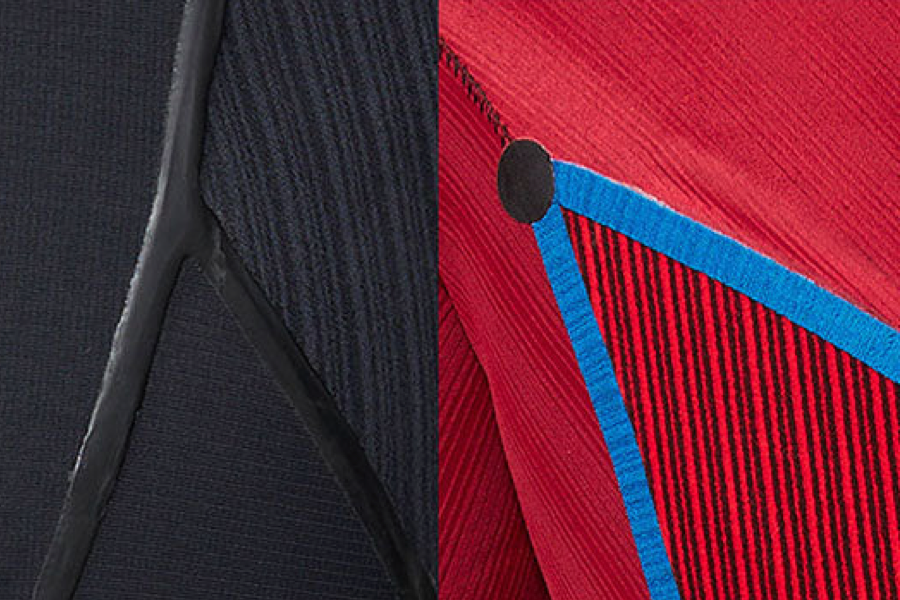In cold water conditions, maintaining a watertight seal is essential to prevent heat loss. To achieve this, wetsuit manufacturers often enhance seams through two additional techniques: seam taping and liquid sealing.
Both methods aim to improve the wetsuit’s performance by reinforcing seams, but they each have distinct advantages and disadvantages.
Why Are Wetsuit Seams Taped?
Seam taping is a method used to reinforce seams by applying a strip of material (usually neoprene tape) over the stitched seams on the inside of the wetsuit. The primary goal is to improve the seam’s water resistance and durability.
-
Watertight Seal: When two pieces of neoprene are stitched together, tiny holes are created along the seam, even in more advanced construction methods like glued and blindstitched (GBS) seams. Taping covers these holes, adding an extra layer of waterproofing. This is especially important for cold-water wetsuits, where water seepage can cause heat loss, leading to discomfort and hypothermia.
-
Enhanced Durability: Taping not only prevents water from entering but also increases the structural strength of the seam. The tape reinforces the stitching, which can be vulnerable to stress in areas that experience high tension, such as the shoulders, knees, and underarms. This additional support reduces the likelihood of seam failure, which extends the wetsuit's lifespan.
-
Improved Comfort: Seam taping provides a smoother interior surface, which reduces irritation and chafing caused by the rough edges of seams. This is particularly beneficial for activities requiring extensive movement, such as surfing or diving.
Types of Seam Taping
There are different types of seam taping techniques used in wetsuit construction:
-
Fully Taped Seams: In this method, every seam in the wetsuit is covered with tape. This provides maximum water resistance and reinforcement, making it ideal for extreme cold-water conditions. However, fully taped seams add to the cost and weight of the wetsuit.
-
Critically Taped Seams: With critically taped seams, only key areas of the wetsuit, such as the chest, back, and shoulders, are taped. This offers a balance between durability and flexibility while keeping the wetsuit lighter and less expensive than fully taped options.
Liquid Seams
Liquid seams are another method of reinforcing and waterproofing wetsuit seams. In this process, a layer of liquid rubber is applied to the outside (or inside) of the stitched seam, creating a smooth and fully sealed finish. Once the liquid rubber cures, it forms a highly durable and waterproof barrier over the seam.
-
Total Water Protection: Liquid seams provide superior water resistance compared to taped seams because the liquid rubber creates a continuous barrier along the entire length of the seam. This prevents even the smallest amount of water from entering the suit.
-
Streamlined Fit: The liquid rubber creates a smooth, flexible finish, allowing the seam to move and stretch with the neoprene. This ensures that the wetsuit remains flexible and comfortable while preventing water seepage. Additionally, the liquid seal’s thin profile avoids adding bulk to the wetsuit, maintaining a more streamlined fit.
-
Durability: Liquid seams are incredibly durable and are often used in high-performance wetsuits designed for cold-water or extreme conditions. Because the liquid rubber seals the seam completely, the neoprene panels are less likely to tear or come apart, extending the life of the wetsuit.
Comparison: Taped Seams vs. Liquid Seams
Both taped and liquid seams are used to improve the waterproofing and durability of wetsuit seams, but they offer different benefits and drawbacks.
-
Water Resistance: Liquid seams are generally more effective at keeping water out than taped seams. The liquid rubber creates a continuous, impenetrable barrier, whereas taped seams still rely on the underlying stitching, which may allow minimal water ingress over time, especially if the tape wears out or degrades.
-
Flexibility and Comfort: Both taped and liquid seams offer excellent flexibility. However, liquid seams tend to be slightly more flexible because the rubber adheres directly to the neoprene and can stretch and move with it more seamlessly. Taped seams can occasionally feel a bit stiffer, particularly in areas where thicker tape is applied.
-
Durability: While both methods enhance durability, liquid seams are generally more robust because the rubber protects the stitching from wear and tear. Taped seams can start to peel away or degrade over time.
-
Cost: Liquid seams are often found on high-end wetsuits because the process is more labor-intensive and expensive than seam taping. Taped seams, particularly critically taped options, are more budget-friendly but may not offer the same level of waterproofing and longevity as liquid seams.
Conclusion
Taped seams and liquid seams both serve to enhance the performance of wetsuits by reinforcing the seams and making them more watertight. Taped seams provide a strong, cost-effective solution, especially for moderate conditions, while liquid seams offer superior water resistance, flexibility, and durability, making them ideal for high-performance wetsuits designed for cold-water activities.
The choice between the two depends on the level of budget, insulation, flexibility, and durability you want.
